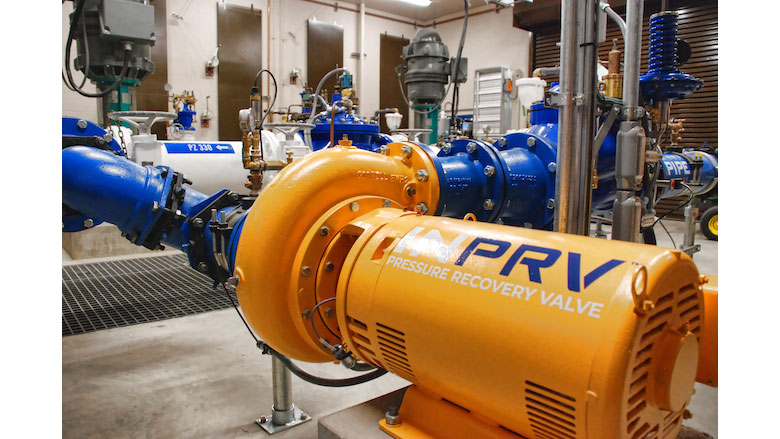Technology to harness the power of water through use of microturbines embedded in water supply lines is gaining traction among utilities.
While hydroelectric dams have powered much of the Pacific Northwest for years, a product developed by Portland, Ore.-based In-Pipe Energy uses a micro-hydroturbine to capture power generated in water pipes themselves to create a renewable source of energy.
Gregg Semler, who founded In-Pipe in 2016 and is CEO, is hopeful that generous renewable energy incentives from the 2022 Inflation Reduction Act (IRA) could spur interest among water utilities and industrial facilities to adopt the technology for their systems.
Some already have. “We’re tapping into an energy source that’s already there and using it to offset energy costs from our pumping station,” says George Sidhu, general manager of the Skagit Public Utility District in Mount Vernon, Wash. The micro-hydro system developed by In-Pipe Energy, called HydroXS, was installed there in 2020 and has been running 20 hours daily, generating 16 to 18 kw and offsetting about $1,000 a month in electricity costs, according to Sidhu.
“The system will pay for itself in eight years,” he says, adding that the utility is planning additional installations, including one that will provide power for a local high school.
It’s no secret that water utilities expend a great deal of energy. The U.S. Environmental Protection Agency estimates the 50,000 water utilities in the U.S. collectively consume 4% of the nation's energy to convey and treat water.
Rising energy costs have become more burdensome, and the water sector as a whole is paying attention to resilience and the impacts faced from climate change, including water scarcity from drought and loss of water from over-pressurized pipes and aging infrastructure. The American Society of Civil Engineers estimates 2 trillion gallons of drinking water are lost each year from burst or leaky pipes.
Innovation can address these issues and help utilities meet their climate goals, but new technology can take as long as 15 years to get to market acceptance, says Barry Liner, chief technical officer of the Water Environment Federation (WEF). “Water people are conservative,” he explains. “If you screw up, people get sick and it can be bad for the environment.
How it Works
In any gravity or pressurized water system, pressure relief valves in pipes are used to regulate downstream pressure for customers. Water flowing from reservoirs or pumping stations is under high pressures and needs to be calibrated for delivery: too much water pressure in a home or business can damage plumbing and wastewater, too little makes showers and clean-ups tedious.
The In-Pipe technology works by replacing or bypassing the valves, which use friction to regulate pressure, and putting a microturbine and generator in its place. Flowing water spins the turbine which drives a generator within the HydroXS box to produce electricity. It's a flexible and adjustable system, operators can monitor and control water flow and pressure to meet their targets, and the renewable energy it generates can be used locally or connect to the grid, according to In-Pipe.
Semler said his company works closely with potential customers in an eight-step process that analyzes their operation and potential energy savings, helps them apply for grants and funding to offset installation costs and even consults with them to understand the state and local regulatory environment for energy generation.
This can be a hurdle for some utilities, especially those that don’t already have renewable energy as part of their operation or an easy pathway to connect to the grid.
“People who work in this industry have a really hard job: they deal with leaky pipes, customers complaining about their water pressure. They are risk adverse and don’t brag about their innovation, they just want to make sure clean safe water comes out of the tap when a customer turns on a faucet,” said Semler. “We make it easy for utilities curious about the potential for renewable energy generation and we do it all for free.”
WEF’s Liner says that micro-hydro turbines are “nothing new,” but that In-Pipe offers an “elegant package that optimizes efficiency and reduces pressure while generating energy.” He says he thinks In-Pipe is a good fit for the water sector.
For now, In-Pipe wants to continue proving the technology with 10 projects operating in the West. Semler expects more interest with the IRA providing billions for energy and water infrastructure projects—funding that can offset up to 60% of the cost of the technology.
“Investment in renewable energy shouldn’t all go to wind and solar, which have environmental costs,” he says. “We’re ready to take off and help utilities and industrial water users generate renewable energy from existing infrastructure and meet their climate commitments.”





